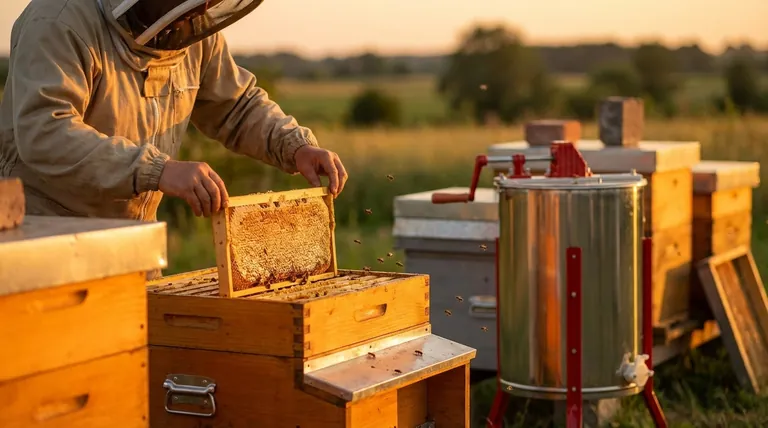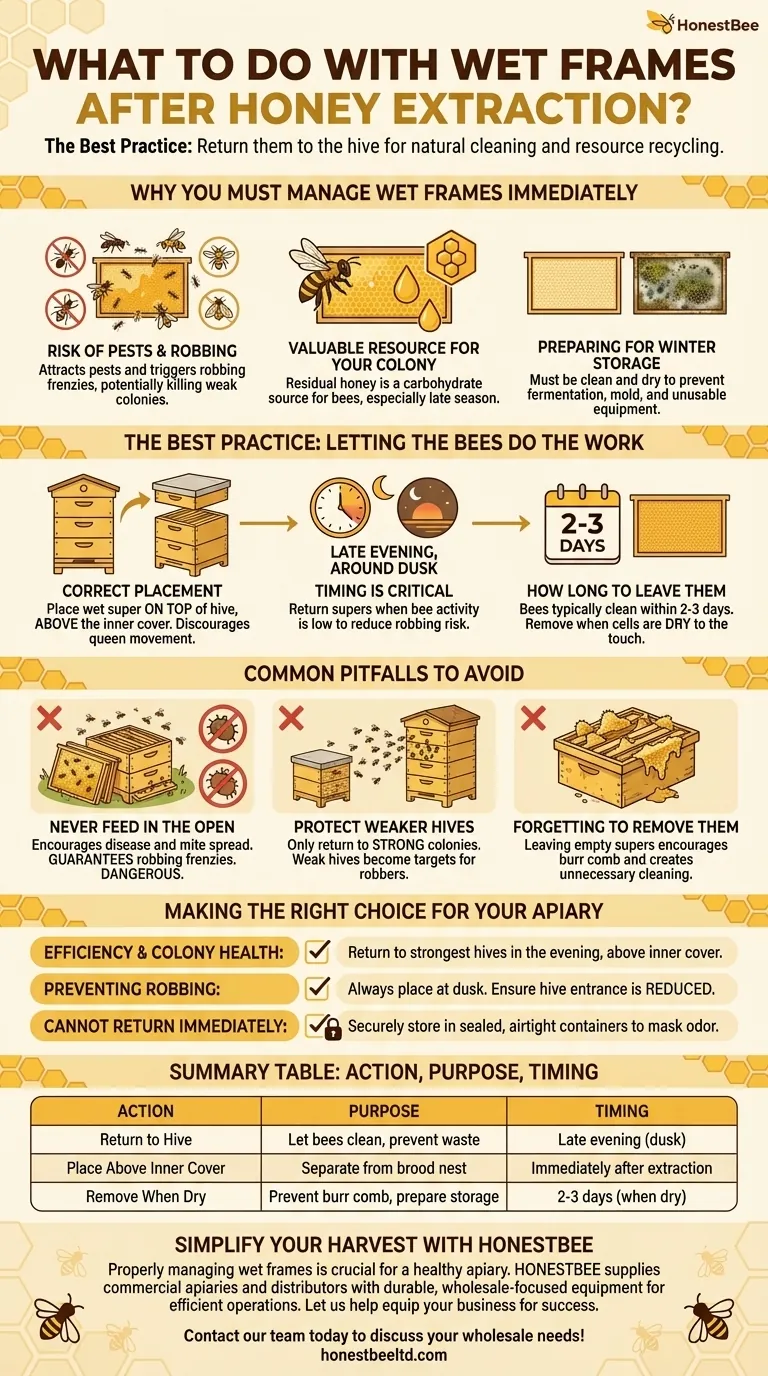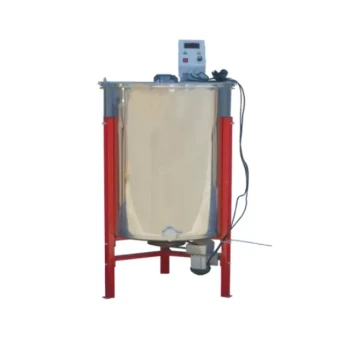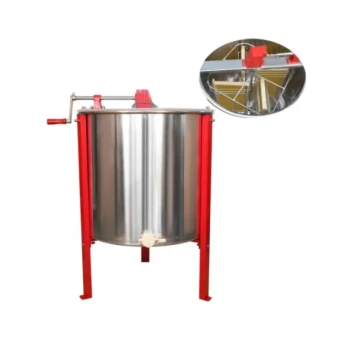The most effective way to handle wet frames after honey extraction is to return them to the hive. This allows your bees to clean off the residual honey, preventing waste and preparing the frames for storage. This simple act recycles a valuable food source back into the colony and uses the bees’ natural behavior to maintain your equipment.
Managing wet honey frames is a critical final step in the extraction process. While the residual honey is a magnet for pests and robbing, it is also a valuable resource that, when returned correctly to the hive, benefits the colony and simplifies your cleanup.

Why You Must Manage Wet Frames Immediately
Leaving frames coated in honey exposed is a liability. The smell of honey is a powerful attractant that can create significant problems for your apiary if not handled with care and intention.
The Risk of Pests and Robbing
Wet frames left in the open or stored improperly will quickly attract pests like ants, wasps, and wax moths. More significantly, they can trigger a robbing frenzy, where bees from stronger nearby colonies attack your hives to steal the exposed honey, often resulting in the death of a weaker colony.
A Valuable Resource for Your Colony
The thin layer of honey remaining on the frames is not waste. For the bees, it is a source of carbohydrates they can store for later use. Returning this resource is especially beneficial if you are harvesting late in the season when nectar sources may be dwindling.
Preparing Frames for Winter Storage
For frames to be stored safely over winter, they must be clean and dry. Frames stored "wet" will ferment and attract mold, mildew, and pests, rendering them unusable for the next season. Allowing the bees to clean them is the most natural and thorough method of preparation.
The Best Practice: Letting the Bees Do the Work
The standard and safest method is to place the wet honey supers back onto the hives that produced them. This process is simple but requires careful timing to avoid problems.
The Correct Placement
Place the super with the wet frames on top of the hive, directly above the inner cover. This positioning creates separation from the main brood nest, which discourages the queen from moving up and laying eggs in the empty comb. The bees will travel up through the hole in the inner cover to clean the frames.
Timing is Critical
The absolute best time to return wet supers to the hive is in the late evening, around dusk. At this time, bee activity is winding down for the day. This simple step dramatically reduces the risk of inciting the robbing behavior that can occur if frames are put out in the middle of a busy day.
How Long to Leave Them
The bees will typically clean the frames completely within two to three days, sometimes even overnight if the colony is strong. You will know they are done when the cells are dry to the touch. Once dry, you can remove the super and store the frames for the winter.
Common Pitfalls to Avoid
While returning frames to the hive is the best practice, there are common mistakes that can turn a helpful act into a harmful one.
Never Feed in the Open
Some beekeepers are tempted to simply stack wet frames in the open air at a distance from the hives for any bees to clean. This is a dangerous practice. Open feeding encourages bees from different colonies to mix, which is a primary way that diseases and mites are spread throughout an apiary. It also guarantees a robbing frenzy.
Protect Weaker Hives
Only return wet frames to strong, healthy colonies. Placing a super full of wet frames on a weak hive can make it a target for robbers from stronger colonies, who may overwhelm the weaker hive's defenses.
Forgetting to Remove Them
Once the frames are clean and dry, remove them promptly. Leaving empty supers on the hive for too long can encourage the bees to build burr comb, creating an unnecessary mess for you to clean up later.
Making the Right Choice for Your Apiary
Your approach should be guided by the health of your colonies and the goal of maintaining a safe, orderly apiary.
- If your primary focus is efficiency and colony health: Return the wet frames to your strongest hives in the evening, placing them above the inner cover for cleaning.
- If your primary focus is preventing robbing at all costs: Always place the frames on the hive at dusk and ensure the hive entrance is reduced, giving your bees a smaller space to defend.
- If you cannot return frames to a hive immediately: Securely store the wet frames in a sealed, airtight container or strong plastic bags to completely mask the honey odor until you can get them back to the bees.
Ultimately, working with your bees' natural cleaning instincts is the most intelligent way to manage your equipment and support the health of your colony.
Summary Table:
| Action | Purpose | Timing |
|---|---|---|
| Return to Hive | Let bees clean residual honey, prevent waste | Late evening (dusk) |
| Place Above Inner Cover | Separate from brood nest, encourage cleaning | Immediately after extraction |
| Remove When Dry | Prevent burr comb, prepare for storage | 2-3 days (when cells are dry) |
Simplify your honey harvest and protect your investment. Properly managing wet frames is crucial for a healthy, productive apiary. At HONESTBEE, we supply commercial apiaries and beekeeping equipment distributors with the durable, wholesale-focused supplies needed for efficient operations like this. Let us help you equip your beekeeping business for success. Contact our team today to discuss your wholesale needs!
Visual Guide

Related Products
- 2 Frame Stainless Steel Manual Honey Spinner Extractor for Beekeeping
- HONESTBEE 72 Frame Industrial Electric Honey Extractor for Beekeeping
- Electric 8 Frame Honey Spinner Extractor Equipment for Beekeeping
- HONESTBEE 6 Frame Self Reversing Electric Honey Extractor for Beekeeping
- Professional 4 Frame Self Reversing Electric Honey Extractor for Beekeeping
People Also Ask
- How do beekeepers harvest honey from the honey super? A Step-by-Step Guide to Efficient Extraction
- What are the advantages of tangential honey extractors? Gentle, Affordable Honey Extraction for Your Apiary
- How can a pressure washer be used to clean a honey extractor? A Guide to Safe and Efficient Cleaning
- Can a manual extractor be upgraded to an electric one? Save Labor & Boost Efficiency
- What mistakes should be avoided during honey extraction with a centrifuge? Preserve Your Comb and Honey Quality



















